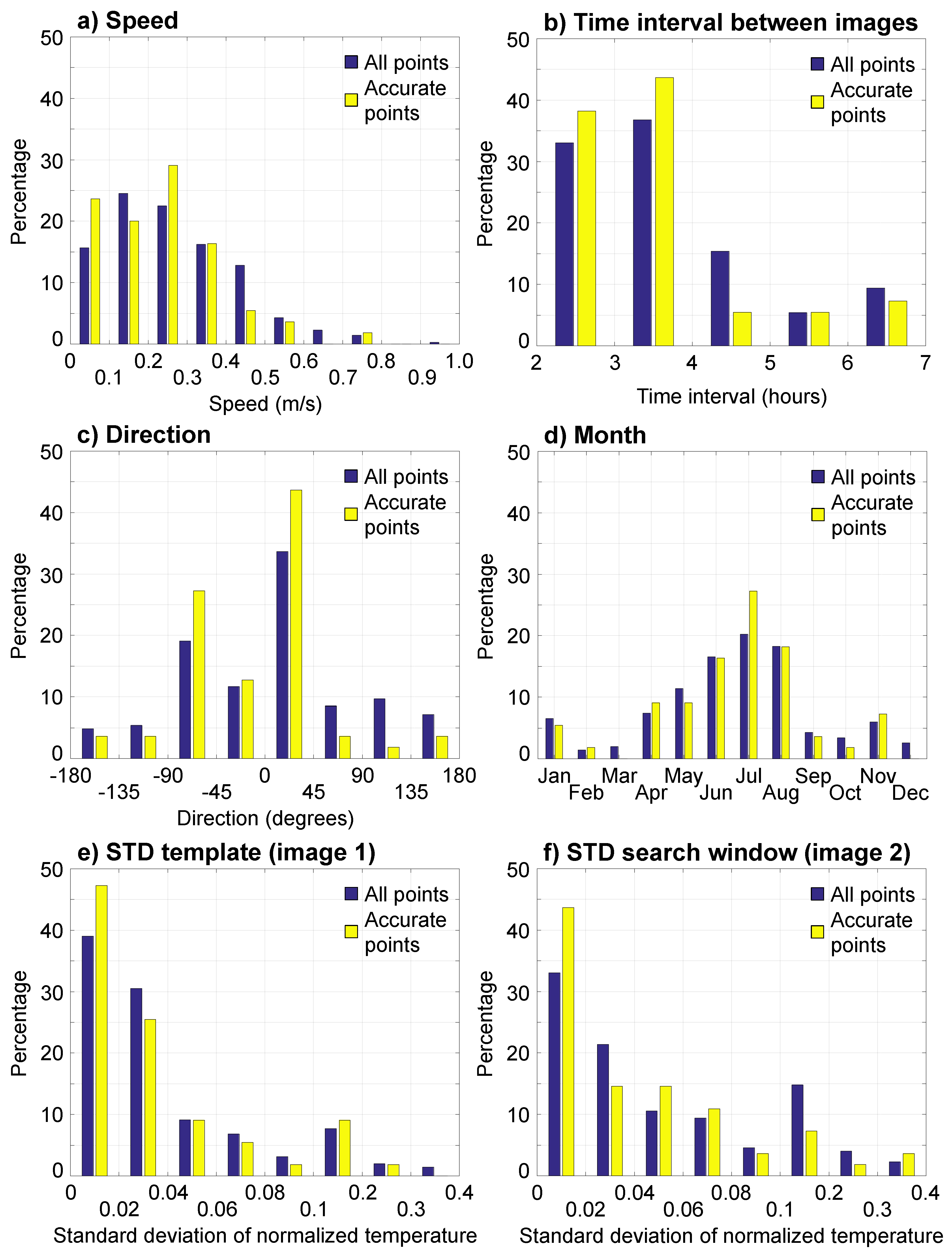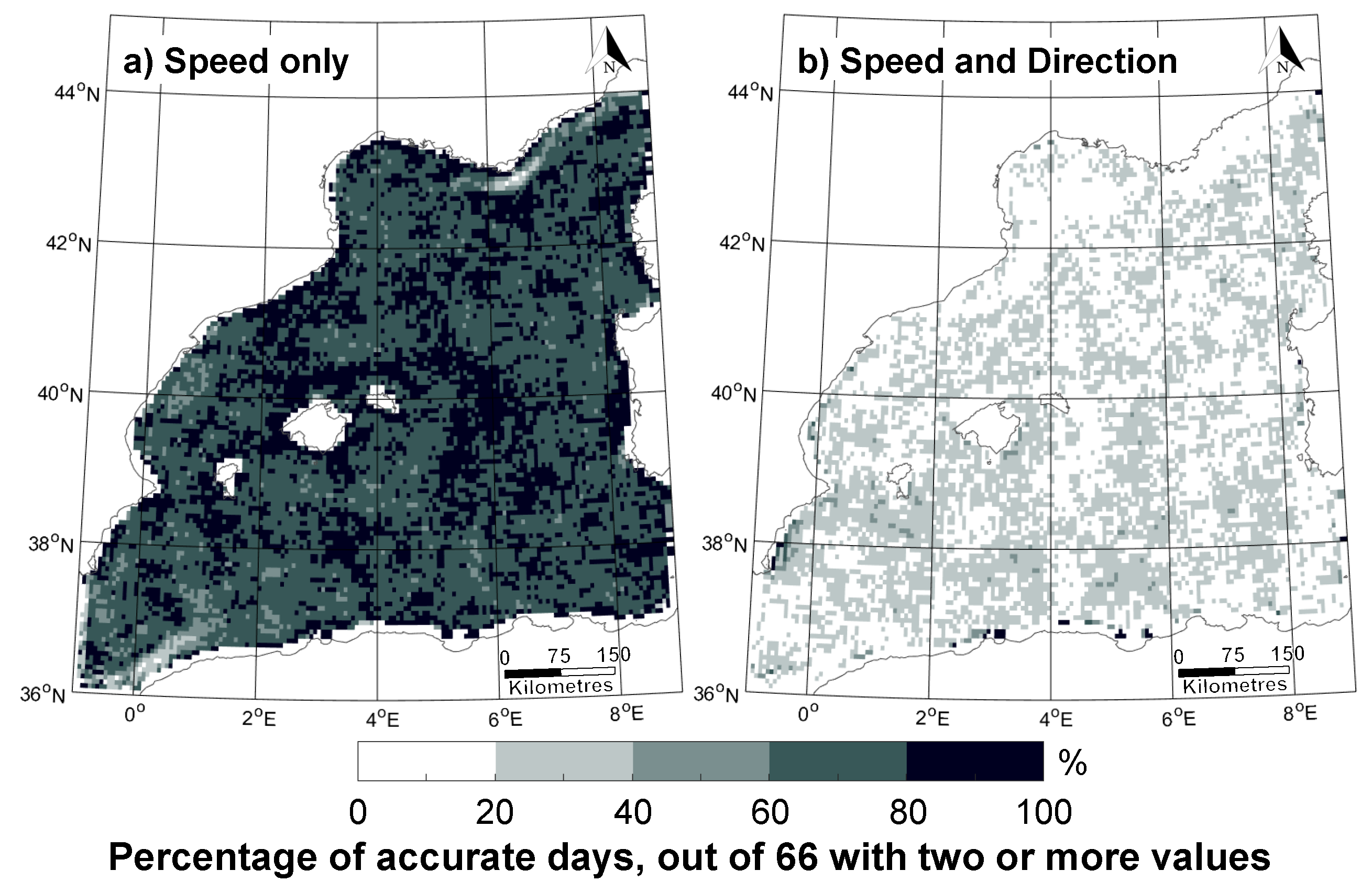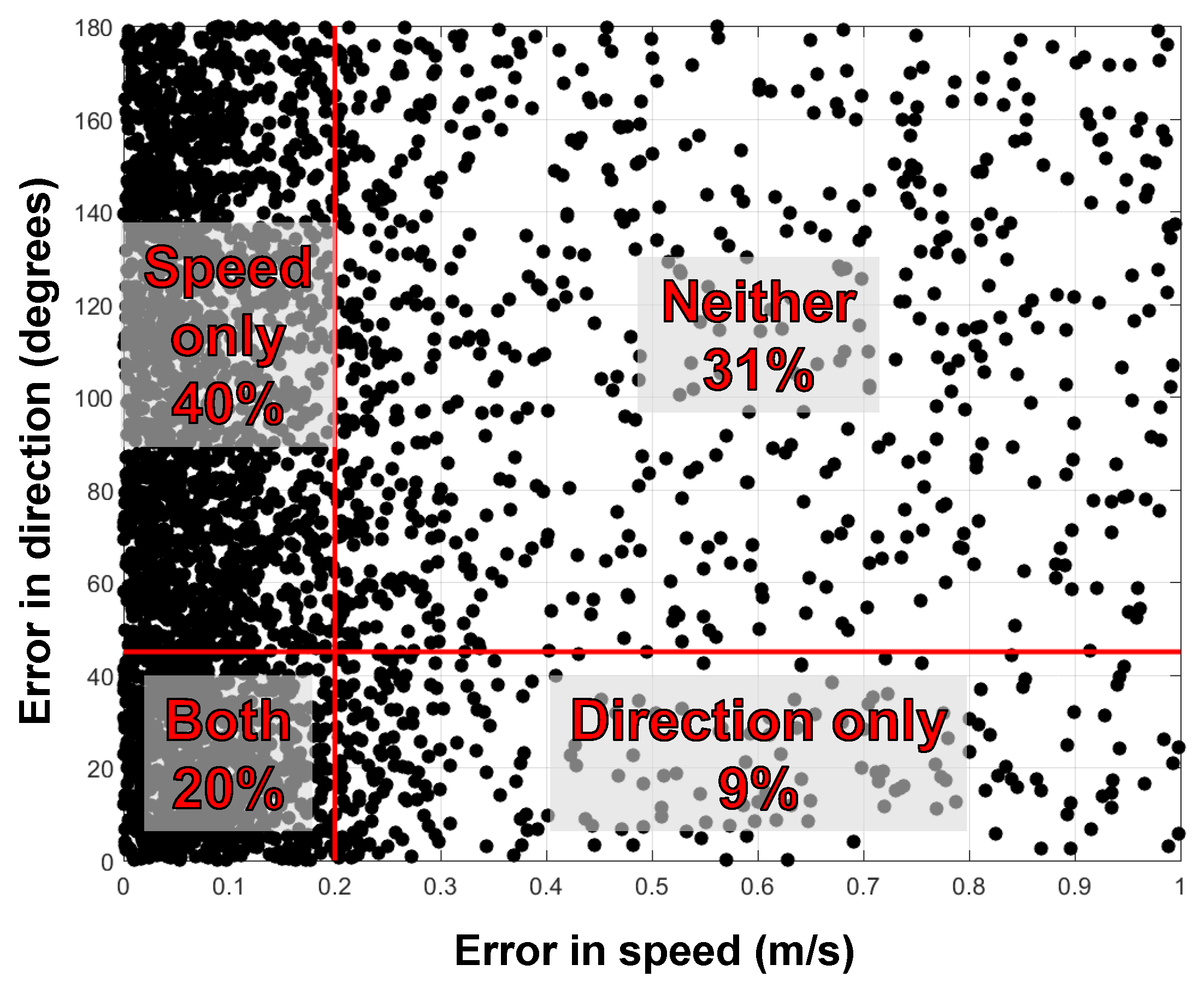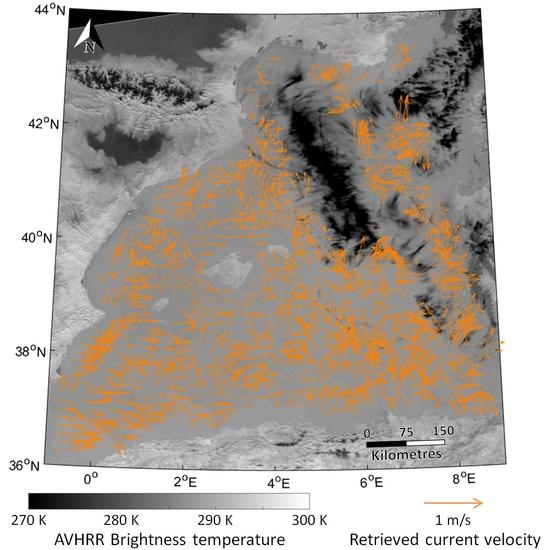Sea Surface Currents Estimated from Spaceborne Infrared Images Validated against Reanalysis Data and Drifters in the Mediterranean Sea
Abstract
:1. Introduction
2. Data and Methods
2.1. Satellite, Drifter, and Reanalysis Data
2.2. Sea Surface Current Retrieval with the Maximum Cross Correlation Algorithm
- the size of the template, that we here define as a box of 5, 10 (default), or 20 km per side;
- the size of the search window, here defined by setting the maximum velocity that the retrieved field cannot exceed to 1.0 m (default), 1.3 m , or 1.8 m ;
- the maximum cross-correlation threshold, which means that velocity values are returned only if the maximum correlation is larger than 0.3, 0.6 (default), or 0.9.
2.3. Methods for Comparison
- we discard both MCC and drifter points with a speed equal to zero, for which a direction cannot be estimated;
- we discard the MCC points that are further than 20 km away from a drifter (Figure 1). We tested different thresholds between 10 and 50 km, and found that the results were not significantly affected by this choice of threshold;
- we discard the MCC points that are within 20 km of each other and whose directions differ by more than . For such points, the uncertainty attached to the MCC result is so high that an agreement with in-situ observation is meaningless (and due to luck).
3. Results and Discussion
3.1. MCC Performance—Sensitivity Experiment
- template window of 10 km by 10 km;
- maximum speed of 1.0 m ;
- correlation threshold R = 0.6;
3.2. MCC Performance—Characteristics of the Images
3.3. MCC and Drifters vs. Reanalysis
4. Summary, Limitations, and Conclusions
- the size of the template window, on the first image;
- the maximum velocity allowed, which determines the size of the search window, on the second image;
- the cutoff threshold in correlation.
Acknowledgments
Author Contributions
Conflicts of Interest
References
- Pisano, A.; De Dominicis, M.; Biamino, W.; Bignami, F.; Gherardi, S.; Colao, F.; Coppini, G.; Marullo, S.; Sprovieri, M.; Trivero, P.; et al. An oceanographic survey for oil spill monitoring and model forecasting validation using remote sensing and in situ data in the Mediterranean Sea. Deep Sea Res. 2016, 133, 132–145. [Google Scholar] [CrossRef]
- Eriksen, M.; Maximenko, N.; Thiel, M.; Cummins, A.; Lattin, G.; Wilson, S.; Hafner, J.; Zellers, A.; Rifman, S. Plastic pollution in the South Pacific subtropical gyre. Mar. Pollut. Bull. 2013, 68, 71–76. [Google Scholar] [CrossRef] [PubMed]
- Klemas, V. Remote Sensing of Coastal and Ocean Currents: An Overview. J. Coast. Res. 2012, 28, 576–586. [Google Scholar] [CrossRef]
- Ronen, D. The effect of oil price on containership speed and fleet size. J. Oper. Res. Soc. 2011, 62, 211–216. [Google Scholar] [CrossRef]
- Paduan, J.; Washburn, L. High-frequency radar observations of ocean surface currents. Annu. Rev. Mar. Sci. 2013, 5, 115–136. [Google Scholar] [CrossRef] [PubMed]
- Hessner, K.; Reichert, K.; Borge, J.; Stevens, C.; Smith, M. High-resolution X-Band radar measurements of currents, bathymetry and sea state in highly inhomogeneous coastal areas. Ocean Dyn. 2014, 64, 989–998. [Google Scholar] [CrossRef]
- Lund, B.; Graber, H.; Hessner, K.; Williams, N. On shipboard marine X-band radar near-surface current “Calibration”. J. Atmos. Ocean. Technol. 2015, 32, 1928–1944. [Google Scholar] [CrossRef]
- Wunsch, C.; Gaposchkin, E. On using satellite altimetry to determine the general circulation of the oceans with application to geoid improvement. Rev. Geophys. 1980, 18, 725–745. [Google Scholar] [CrossRef]
- Emery, W.J.; Thomas, A.C.; Collins, M.J.; Crawford, W.R.; Mackas, D.L. An objective method for computing advective surface velocities from sequential infrared satellite images. J. Geophys. Res. Oceans 1986, 91, 12865–12878. [Google Scholar] [CrossRef]
- Tokmakian, R.; Strub, P.T.; McClean-Padman, J. Evaluation of the maximum cross–correlation method of estimating sea surface velocities from sequential satellite images. J. Atmos. Ocean Technol. 1990, 7, 852–865. [Google Scholar] [CrossRef]
- Warren, M.A.; Quartly, G.D.; Shutler, J.D.; Miller, P.I.; Yoshikawa, Y. Estimation of ocean surface currents from maximum cross correlation applied to GOCI geostationary satellite remote sensing data over the Tsushima (Korea) Straits. J. Geophys. Res. Oceans 2016, 121, 6993–7009. [Google Scholar] [CrossRef]
- Shutler, J.D.; Quartly, G.D.; Donlon, C.J.; Sathyendranath, S.; Platt, T.; Chapron, B.; Johannessen, J.A.; Girard-Ardhuin, F.; Nightingale, P.D.; Woolf, D.K.; et al. Progress in satellite remote sensing for studying physical processes at the ocean surface and its borders with the atmosphere and sea ice. Prog. Phys. Geogr. 2016, 40, 215–246. [Google Scholar] [CrossRef]
- Emery, W.J.; Fowler, C.; Clayson, C.A. Satellite-image-derived Gulf Stream currents compared with numerical model results. J. Atmos. Ocean Technol. 1992, 9, 286–304. [Google Scholar] [CrossRef]
- Bowen, M.M.; Emery, W.J.; Wilkin, J.L.; Tildesly, P.C.; Barton, I.J.; Knewtson, R. Extracting multiyear surface currents from sequential thermal imagery using the maximum cross-correlation technique. J. Atmos. Ocean Technol. 2002, 19, 1665–1676. [Google Scholar] [CrossRef]
- Wahl, D.D.; Simpson, J.J. Physical processes affecting the objective determination of near surface velocity from satellite data. J. Geophys. Res. Oceans 1990, 95, 13511–13528. [Google Scholar] [CrossRef]
- Heuzé, C.; Carvajal, G.K.; Eriksson, L.E.B. Optimisation of sea surface current retrieval using a maximum cross correlation technique on modelled sea surface temperature. J. Atmos. Ocean Technol. 2017. submitted. [Google Scholar]
- Doronzo, B.; Taddei, S.; Brandini, C.; Fattorini, M. Extensive analysis of potentialities and limitations of a maximum cross-correlation technique for surface circulation by using realistic ocean model simulations. Ocean Dyn. 2015, 65, 1183–1198. [Google Scholar] [CrossRef]
- Holloway, G.; Nguyen, A.; Wang, Z. Oceans and ocean models as seen by current meters. J. Geophys. Res. Oceans 2011, 116, C00D08. [Google Scholar] [CrossRef]
- Millot, C. Circulation in the western Mediterranean Sea. J. Mar. Sys. 1999, 20, 423–442. [Google Scholar] [CrossRef]
- Isern-Fontanet, J.; García-Ladona, E.; Font, J. Vortices of the Mediterranean Sea: An altimetric perspective. J. Phys. Ocean. 2006, 36, 87–103. [Google Scholar] [CrossRef]
- Pinardi, N.; Masetti, E. Variability of the large scale general circulation of the Mediterranean Sea from observations and modelling: A review. Palaeogeogr. Palaeoclimatol. Palaeoecol. 2000, 158, 153–173. [Google Scholar] [CrossRef]
- Madec, G. NEMO Ocean General Circulation Model Reference Manuel; Technical Report; LODYC/IPSL: Paris, France, 2008. [Google Scholar]
- Tolman, H.L. User Manual and System Documentation of WAVEWATCH III TM Version 3.14; Technical Report, MMAB Contribution 276; MMAB: College Park, MD, USA, 2009. [Google Scholar]
- Lecci, R.; Drudi, M.; Grandi, A.; Fratianni, C. PRODUCT USER MANUAL for Mediterranean Sea Physical Analysis and Forecasting Product MEDSEA_ANALYSIS_FORECAST_PHYS_006_001; EU Copernicus Marine Environment Monitoring Service: Vincennes, France, 2016. [Google Scholar]
- Wessel, P.; Smith, W. A global, self-consistent, hierarchical, high-resolution shoreline database. J. Geophys. Res. B Solid Earth 1996, 101, 8741–8743. [Google Scholar] [CrossRef]
- Matthews, D.K.; Emery, W.J. Velocity observations of the California Current derived from satellite imagery. J. Geophys. Res. Oceans 2009, 114, 2156–2202. [Google Scholar] [CrossRef]
- Chubb, S.R.; Mied, R.P.; Shen, C.Y.; Chen, W.; Evans, T.E.; Kohut, J. Ocean surface currents from AVHRR imagery: Comparison with land-based HF radar measurements. IEEE Trans. Geosci. Remote Sens. 2008, 46, 3647–3660. [Google Scholar] [CrossRef]
- Longuet-Higgins, M.S. On the transport of mass by time–varying ocean currents. Deep Sea Res. 1969, 16, 431–447. [Google Scholar] [CrossRef]
- Qazi, W.A.; Emery, W.J.; Fox-Kemper, B. Computing Ocean Surface Currents Over the Coastal California Current System Using 30–Min–Lag Sequential SAR Images. IEEE Trans. Geosci. Remote Sens. 2014, 52, 7559–7580. [Google Scholar] [CrossRef]
- Flato, G.; Marotzke, J.; Abiodun, B.; Braconnot, P.; Chou, S.C.; Collins, W.J.; Cox, P.; Driouech, F.; Emori, S.; Eyring, V.; et al. Evaluation of Climate Models. In Climate Change 2013: The Physical Science Basis. Contribution of Working Group I to the Fifth Assessment Report of the Intergovernmental Panel on Climate Change; Cambridge University Press: Cambridge, UK; New York, NY, USA, 2013. [Google Scholar]





| Template Size | 10 km | 5 km | 20 km | 10 km | 10 km | 10 km | 10 km |
| Maximum Velocity | 1.0 m | 1.0 m | 1.0 m | 1.3 m | 1.8 m | 1.0 m | 1.0 m |
| Correlation | R = 0.6 | R = 0.6 | R = 0.6 | R = 0.6 | R = 0.6 | R = 0.3 | R = 0.9 |
| Speed Only | 56% | 63% | 45% | 45% | 40% | 51% | 53% |
| Direction Only | 28% | 23% | 29% | 28% | 30% | 32% | 24% |
| Speed and Direction | 16% | 12% | 13% | 14% | 11% | 17% | 12% |
| Total Points | 351 | 293 | 176 | 353 | 359 | 317 | 337 |
| MCC-drifter | MCC-Reanalysis | Drifter-Reanalysis | ||
|---|---|---|---|---|
| Speed | mean | m | 0.08 m | 0.31 m |
| RMSE | 0.51 m | 0.19 m | 1.09 m | |
| Direction | mean | |||
| RMSE |
© 2017 by the authors. Licensee MDPI, Basel, Switzerland. This article is an open access article distributed under the terms and conditions of the Creative Commons Attribution (CC BY) license (http://creativecommons.org/licenses/by/4.0/).
Share and Cite
Heuzé, C.; Carvajal, G.K.; Eriksson, L.E.B.; Soja-Woźniak, M. Sea Surface Currents Estimated from Spaceborne Infrared Images Validated against Reanalysis Data and Drifters in the Mediterranean Sea. Remote Sens. 2017, 9, 422. https://doi.org/10.3390/rs9050422
Heuzé C, Carvajal GK, Eriksson LEB, Soja-Woźniak M. Sea Surface Currents Estimated from Spaceborne Infrared Images Validated against Reanalysis Data and Drifters in the Mediterranean Sea. Remote Sensing. 2017; 9(5):422. https://doi.org/10.3390/rs9050422
Chicago/Turabian StyleHeuzé, Céline, Gisela K. Carvajal, Leif E. B. Eriksson, and Monika Soja-Woźniak. 2017. "Sea Surface Currents Estimated from Spaceborne Infrared Images Validated against Reanalysis Data and Drifters in the Mediterranean Sea" Remote Sensing 9, no. 5: 422. https://doi.org/10.3390/rs9050422







